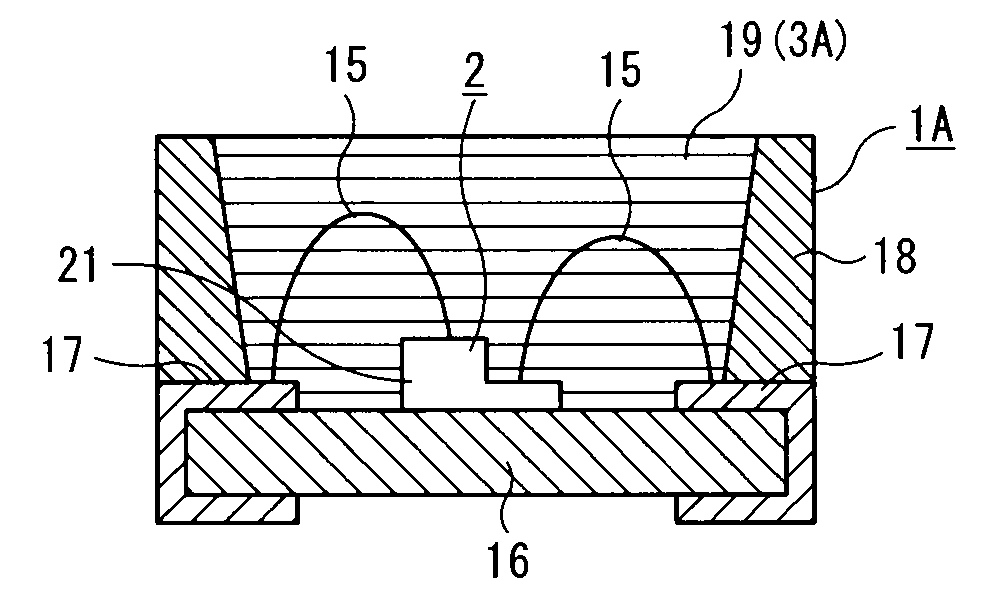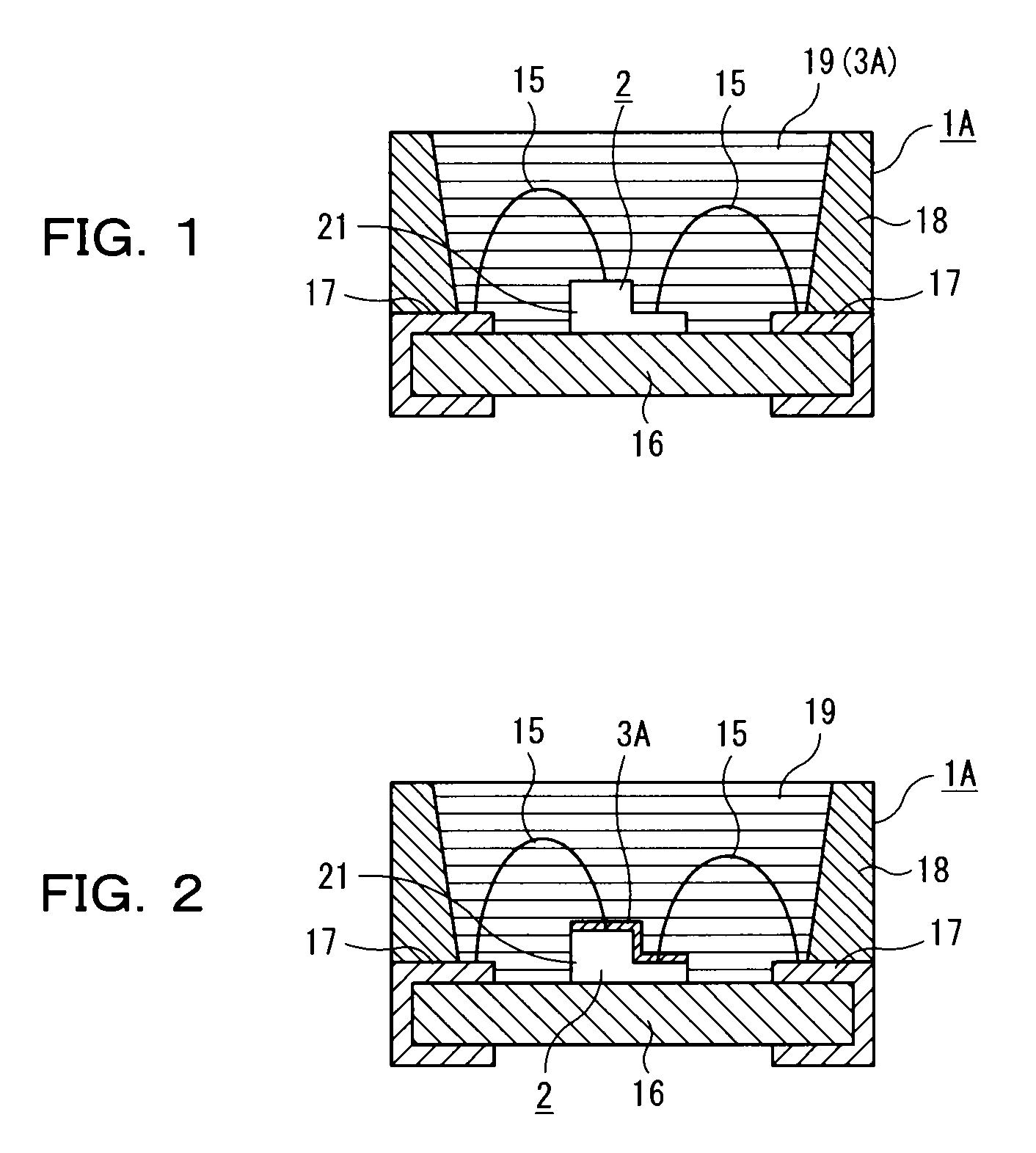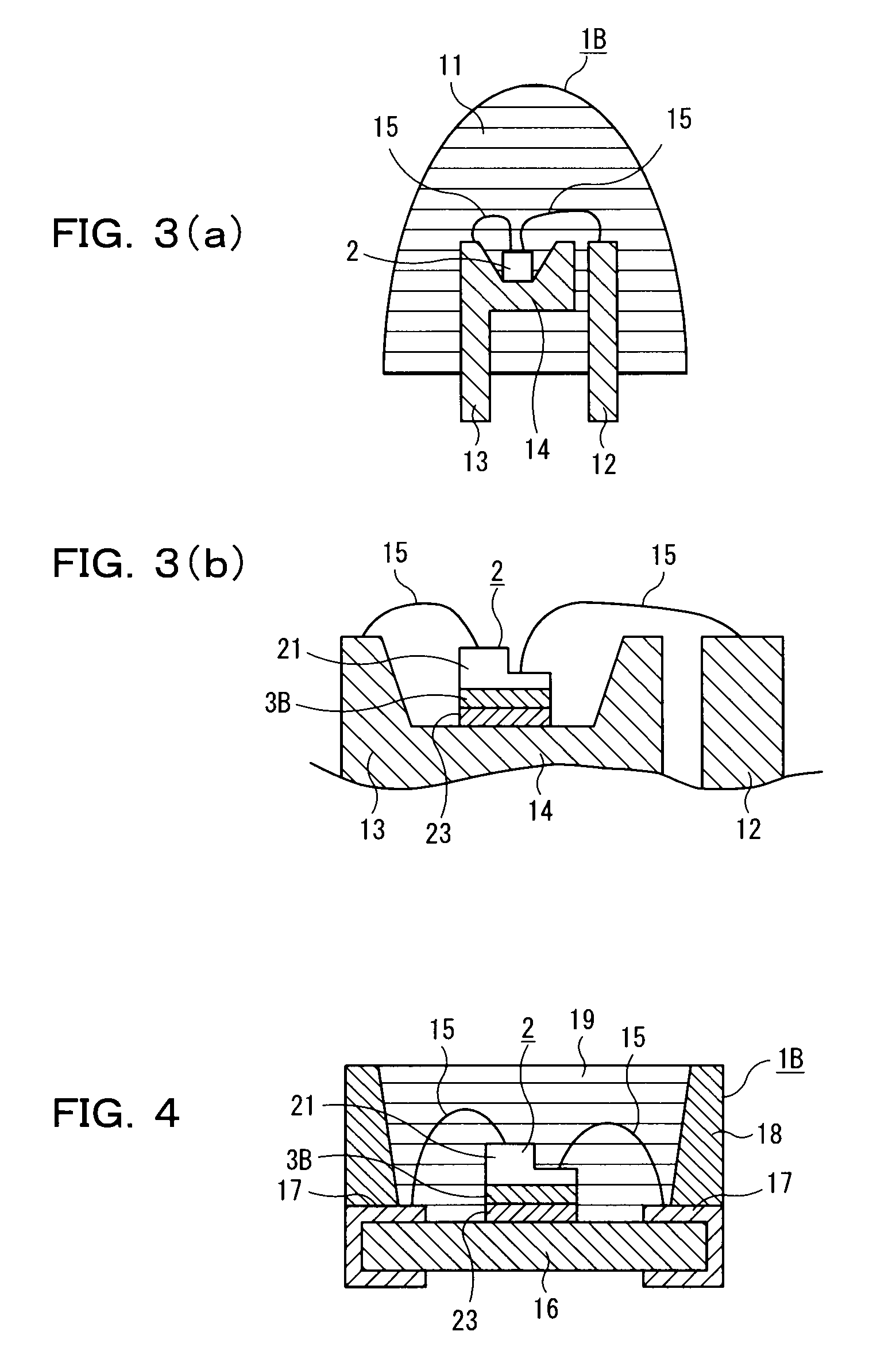Member for semiconductor light emitting device and method for manufacturing such member, and semiconductor light emitting device using such member
a light-emitting device and semiconductor technology, applied in semiconductor devices, solid-state devices, coatings, etc., can solve the problems of silicon resin scratching, dramatic decrease in the brightness of the semiconductor light-emitting device, and degradation of phosphor, so as to achieve superior light resistance and heat resistance, and high brightness
- Summary
- Abstract
- Description
- Claims
- Application Information
AI Technical Summary
Benefits of technology
Problems solved by technology
Method used
Image
Examples
embodiment a-1
[0445]In light emitting device 1A of the present embodiment, as shown in FIG. 1, luminous element 2 is surface-mounted on an insulating substrate 16 on which printed wiring 17 is carried out. In luminous element 2, a p-type semiconductor layer (not shown) and an n-type semiconductor layer (not shown) in a luminous layer part 21 are connected electrically to printed wirings 17 and 17 via conductive wires 15 and 15 respectively. Conductive wires 15 and 15 have a small cross section so that the light emitted from luminous element 2 may not be blocked.
[0446]As luminous element 2, one that emits light of any wavelengths, from ultraviolet to infrared regions, may be used. In this embodiment, a gallium nitride LED chip is assumed to be used. In luminous element 2, an n-type semiconductor layer (not shown) is formed on the lower side in FIG. 1 and a p-type semiconductor layer (not shown) is formed on the upper side in the same. The upper side of FIG. 1 is assumed to be the front side in the...
embodiment a-2
[0450]Light emitting device 1A of the present embodiment is structured, as shown in FIG. 2, in the same manner as the above embodiment A-1, except that the front side of luminous element 2 is covered with transparent member 3A and sealing part 19, formed on member 3A. Sealing part 19 is formed of a material different from that of transparent member 3A. Transparent member 3A on the surface of luminous element 2 is a transparent thin film, functioning as a light extracting film and sealing film. Transparent member 3A can be formed, for example, by coating the above liquid for forming the semiconductor light-emitting device member, by a method of spin coating or the like, during the formation process of a chip of luminous element 2. Meanwhile, the same components as in embodiment A-1 are designated by the same reference numerals to omit redundant explanations.
[0451]Thus, because light emitting device 1A of the present embodiment is also provided with luminous element 2 and transparent ...
embodiment b-1
[0453]Light emitting device 1B of the present embodiment is provided, as shown in FIG. 3(a), with luminous element 2 comprised of an LED chip and a mold part 11 obtained by forming a light-transmissible and transparent material into a shell type shape. Mold part 11 covers luminous element 2. Luminous element 2 is electrically connected to lead terminals 12 and 13, formed of a conductive material. Lead terminals 12 and 13 are formed of a lead frame.
[0454]Luminous element 2 is comprised of a gallium nitride LED chip. In luminous element 2, an n-type semiconductor layer (not shown) is formed on the lower side in FIG. 3(a) and a p-type semiconductor layer (not shown) is formed on the upper side in the same. The upper sides of FIG. 3(a) and FIG. 3(b) are assumed to be the front sides in the following description because light output is extracted from the side of the p-type semiconductor layer. The rear surface of luminous element 2 is joined to a mirror (cup part) 14, which is attached t...
PUM
| Property | Measurement | Unit |
|---|---|---|
| transmittance | aaaaa | aaaaa |
| temperature | aaaaa | aaaaa |
| wavelength | aaaaa | aaaaa |
Abstract
Description
Claims
Application Information
 Login to View More
Login to View More - R&D
- Intellectual Property
- Life Sciences
- Materials
- Tech Scout
- Unparalleled Data Quality
- Higher Quality Content
- 60% Fewer Hallucinations
Browse by: Latest US Patents, China's latest patents, Technical Efficacy Thesaurus, Application Domain, Technology Topic, Popular Technical Reports.
© 2025 PatSnap. All rights reserved.Legal|Privacy policy|Modern Slavery Act Transparency Statement|Sitemap|About US| Contact US: help@patsnap.com



